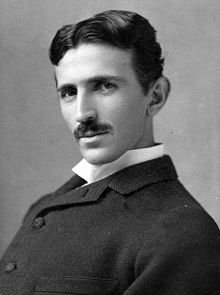|
Nikola Tesla
(Serbian Cyrillic: Никола Тесла; 10 July
1856 – 7 January 1943) was a Serbian
American[2][3][4] inventor, electrical
engineer, mechanical engineer, and futurist
best known for his contributions to the design of the modern alternating current
(AC) electricity supply system.[5]
the design of the modern alternating current
(AC) electricity supply system.[5]
Tesla gained experience in telephony and
electrical engineering before immigrating to
the United States in 1884 to work for Thomas
Edison in New York City. He soon struck out
on his own with financial backers, setting
up laboratories and companies to develop a
range of electrical devices. His patented AC
induction motor and transformer were
licensed by George Westinghouse, who also
hired Tesla for a short time as a
consultant. His work in the formative years
of electric power development was involved
in a corporate alternating current/direct
current "War of Currents" as well as various
patent battles. Tesla went on to pursue his
ideas of wireless lighting and electricity
distribution in his high-voltage,
high-frequency power experiments in New York
and Colorado Springs and made early (1893)
pronouncements on the possibility of
wireless communication with his devices. He
tried to put these ideas to practical use in
his ill-fated attempt at intercontinental
wireless transmission, which was his
unfinished Wardenclyffe Tower project.[6] In
his lab he also conducted a range of
experiments with mechanical
oscillators/generators, electrical discharge
tubes, and early X-ray imaging. He also
built a wireless controlled boat, one of the
first ever exhibited.
Tesla was renowned for his achievements and
showmanship, eventually earning him a
reputation in popular culture as an
archetypal "mad scientist."[7] His patents
earned him a considerable amount of money,
much of which was used to finance his own
projects with varying degrees of
success.[8]:121,154 He lived most of his
life in a series of New York hotels, through
his retirement. He died on 7 January
1943.[9] His work fell into relative
obscurity after his death, but in 1960 the
General Conference on Weights and Measures
named the SI unit of magnetic flux density
the tesla in his honor.[10] Tesla has
experienced a resurgence in interest in
popular culture since the 1990s.
|

